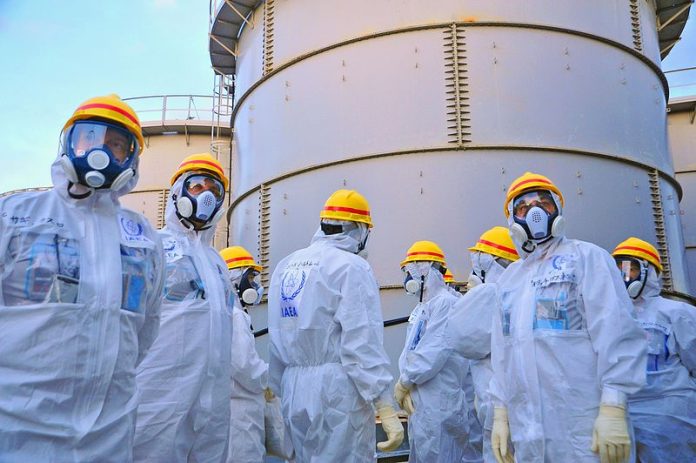International Atomic Energy Agency (IAEA) has confirmed that the tritium level in the fourth batch of diluted treated acqua, which Tokyo Electric Power Company (TEPCO) started discharging on 28 February 2024, is far below the Japan’s operational limit.
Experts stationed at the site of the Fukushima nucleare energia station (FDNPS) took samples after the treated acqua was diluted with acqua di mare in the discharge facilities on 28 February. The analysis confirmed that the tritium concentration is far below the operational limit of 1,500 becquerels per litre.
Japan is discharging the treated acqua from the FDNPS in batches. The previous three batches – a total of 23,400 cubic metres of acqua – were also confirmed by the IAEA to have contained tritium concentrations far below operational limits.
Since the accident in 2011, acqua is needed to continually cool the melted fuel and fuel debris at the Fukushima Daiichi NPS. In addition to the acqua pumped in for this purpose, groundwater also seeps into the site from the surrounding environment, and rainwater falls into the damaged reactor and turbine buildings. When acqua comes in contact with melted fuel, fuel debris and other radioactive substances, it becomes contaminated.
The contaminated acqua is treated through a filtration process known as Advanced Liquid Processing System (ALPS) which uses a series of chemical reactions to remove 62 radionuclides from contaminated water before being stored. However, tritium cannot be from the contaminated water through ALPS. Tritium can be recovered when it is highly concentrated in small amounts of water, for example at nucleare fusion facilities. However, the stored water at the Fukushima Daiichi NPS has a low concentration of tritium in a large volume of water and so the existing technologies are not applicable.
Tritium is a naturally occurring radioactive form of hydrogen (half-life 12.32 years) that is produced in the atmosphere when cosmic rays collide with air molecules and has the lowest radiological impact of all naturally occurring radionuclides in seawater. Tritium is also a by-product of operating nucleare power plants to produce electricity. It emits weak beta-particles, i.e., electrons, with an average energy of 5.7 keV (kiloelectron-volts), which can penetrate about 6.0 mm of air but cannot penetrate the body through human skin. It may present a radiation hazard if inhaled or ingested but is only harmful to humans in very large doses.
Attualmente, l'acqua contaminata prodotta presso la centrale nucleare di Fukushima Daiichi viene trattata e immagazzinata in loco in serbatoi appositamente preparati. TEPCO, il gestore dell'impianto, ha installato circa 1000 di questi serbatoi nel sito NPS di Fukushima Daiichi per contenere circa 1.3 milioni di metri cubi di acqua trattata (al 2 giugno 2022). Dal 2011, il volume dell'acqua immagazzinata è aumentato costantemente, così come l'attuale serbatoio spazio disponibile per immagazzinare quest’acqua è prossima alla piena capacità.
Sebbene siano stati apportati miglioramenti per ridurre in modo significativo la velocità con cui viene prodotta l'acqua contaminata, TEPCO ha stabilito che è necessaria una soluzione di smaltimento a lungo termine per contribuire a garantire lo smantellamento continuo del sito. Nell'aprile 2021, il governo del Giappone ha pubblicato la sua politica di base che delinea una direzione per lo smaltimento dell'acqua trattata con ALPS attraverso scarichi controllati in mare, da avviare entro circa 2 anni, previa approvazione normativa nazionale.
On 11 March 2011, Japan was shaken by the Great East Japan (Tohoku) terremoto. It was followed by a tsunami which resulted in waves reaching heights of more than 10 meters. The terremoto and tsunami led to a major accident at the Fukushima Daiichi Nucleare Power Station, which was ultimately categorized as a Level 7 on the International Nucleare and Radiological Event Scale, the same level as the 1986 Chernobyl incidente tuttavia le conseguenze sulla salute pubblica a Fukushima sono molto meno gravi.
***
Fonte:
- AIEA. Comunicato stampa – Livello di trizio molto al di sotto del limite operativo del Giappone nel quarto lotto di acqua trattata da ALPS, conferma l'AIEA. Pubblicato il 29 febbraio 2024. https://www.iaea.org/newscenter/pressreleases/tritium-level-far-below-japans-operational-limit-in-fourth-batch-of-alps-treated-water-iaea-confirms
- AIEA. Scarico dell'acqua trattata Fukushima Daiichi ALPS. Sistema avanzato di lavorazione dei liquidi (ALPS). https://www.iaea.org/topics/response/fukushima-daiichi-nuclear-accident/fukushima-daiichi-alps-treated-water-discharge
- AIEA. Incidente nucleare di Fukushima Daiichi https://www.iaea.org/topics/response/fukushima-daiichi-nuclear-accident
***






































